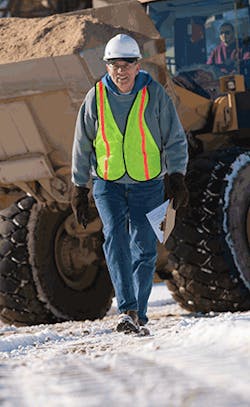Winter Safety from Head to Toe
Santa Claus is the ultimate winter warrior. He comes like clockwork, every year, working a grueling 24-hour shift so that all the little boys and girls receive presents (or coal).
Santa is prepared for the cold weather. This fictional character almost seems to have PPE down to a tee: hat, gloves, waterproof boots and layered clothing.
However, unlike Santa, outdoor workers typically work year-round, rain, sleet, snow or shine with a similarly hectic schedule. So, an employer must take the time to prepare and educate workers about exposure to colder temperatures to avoid injuries and illnesses.
A 2014 study from the National Center from Health Statistics examined weather-related mortality rates between 2006-2010. It showed that more than two-thirds of deaths in the United States were attributed to excessive cold, compared to one-third of heat-related deaths.
Workers or those with preexisting chronic conditions – including cardiovascular and respiratory diseases, conditions that impair thermoregulatory function and those taking various medications – are more susceptible to cold effects, the NCHS study stated.
For outdoor workers, cold stress, hypothermia, frostbite, trench foot, and chilblains are the most common ailments. However, with the proper protection and training, winter-related injuries are preventable.
The First Step
As with all safety measures, the first step to protecting workers from winter conditions is a job hazard analysis (JHA), says Joe Corvello, corporate director of health and safety at American Bridge Co., a 2016 America's Safest Companies winner.
Assessments should be based on geographic location, type of work environment and duration of work activity exposed to the elements.
Next, the safety leader should perform a PPE assessment to meet the requirements identified in the risk assessment or JHA.
The safety leader also should identify training requirements to educate workers on cold weather working, the risks and hazards associated with that working environment and the PPE required to protect them from the elements and hazards associated with the work activity, Corvello says.
Donald Garvey, construction technical specialist at 3M, says both workers and supervisors should be trained on the following:
- Hazards of cold work.
- The initial signs and symptoms of cold stress.
- Basic first aid for cold stress – especially frost bite and hypothermia.
- The use of a buddy system to monitor each other.
- Eating and drinking habits on the job and after work and the need to rehydrate.
- Sweating which is a cooling mechanism for the body.
- Medication and other susceptibility factors which could cause cold sensitivity.
- Clothing – keep it loose, dry and layered.
Once all of the above assessments have been completed, a cold weather working plan specific to the project location and environment can be completed, Corvello says. Additional information in a cold weather plan will cover winterization of equipment, protection of permanent materials in place, snow removal and monitoring/surveillance.
"Having a good winter working plan in place to identify snow removal, gritting and temperature work restriction demonstrates a company's commitment to keeping workers safe," he says.
Proper Protection
Even though it may seem like common knowledge to bundle up in cold weather, some workers have not experienced longer exposure to winter conditions or are not conditioned, which could present a hazard if they underestimate Mother Nature. Appropriate PPE exists for all extremities and should be utilized as temperatures drop.
Head
One thing is certain: workers should be protected from head to toe. Starting from the top, a head covering is essential. Specially-designed liners and coverings can work with helmets and hard hats to provide protection in the cold, says Jason Lindula, safety coordinator at Egan Co., a 2014 America's Safest Companies recipient.Eyes
A worker's eyes must remain protected 100 percent of the time to prevent snow blindness and damage from UV rays."Typically during winter weather, high winds and sun glare are the most risk to eyes," Corvello says. "Polarized, foamed-sealed safety glasses with anti-fog provide the best protection from wind chill, debris and sun glare."
Snow blindness, a condition in which UV rays essentially sunburn the cornea, can be a hazard in winter environments, especially when working at higher elevations, Garvey says. While it is called snow blindness, snow is not required for it to occur. Water or any reflective surface can create the same hazard.
"Even on cloudy days, eye protection should still be worn, as UV radiation may still penetrate the cloud cover," he warns.
Body
A multi-layering approach to clothing is crucial to protecting workers during hazardous, ever-changing winter weather conditions."With all three layers it is nice to have zipper openings," Garvey suggests. "This allows venting of sweat and customizing the insulation properties to the specific environment to minimize sweating."
Because weather conditions can change throughout the day, employees can remove or adjust layers. In addition, each layer has a specific purpose. Garvey specifies:
- Layer 1 (closest to the skin) – A polypropylene or similar wicking material. This helps draw sweat away from the body to keep the skin dry.
- Layer 2 (middle layer) – An insulating layer of wool or polar fleece-type materials. This provides insulation even when wet. Cotton should not be used as the insulating layer as it quickly loses its insulation properties when wet.
- Layer 3 (outer layer) – A nylon or similar material to block the wind.
Winter layers can be bulky, but don't wear loose clothing that could get caught in machinery, Corvello says. Workers should bring dry clothes to work to change if clothing gets wet, and regular PPE such as safety vest should still be worn over winter items.
Hands
Just as with eyewear, companies should require workers to wear gloves at all times. Gloves for winter work should still be task-specific, such as cut-resistant, while also providing insulation and dexterity, Lindula says.The use of glove liners can be used with cut-resistant or chemical gloves, Corvello suggests.
Footwear
For outdoor workers, studded overshoes with waterproof properties can provide insulation as well as traction on ice and snow to prevent slips, trips and falls, Lindula says. Shoe/boot coverings with studs also are available.Shifting Work Indoors
Finally, if conditions prove to be too hazardous, outdoor work should be moved to a different day, depending on the weather forecast and the availability of indoor job tasks."Ideally, we like to be inside but we know that's not always the case. Just because the news says one thing, your location may be different," Lindula says. "If we don't think it's safe to be outside working, we find interior work and put outdoor work off for another day."
Company policies or guidelines should be addressed prior to the start of the winter season. For Egan Co., if the wind chill hits a certain threshold at 6 a.m., employees are not required to come in unless there is interior work that safely can be done. If temperatures rise throughout the day, workers could be asked to come in at a later time. If hazardous conditions arise later in the day, this is addressed as well.
"Our jobsites will shut down early so employees can go home and don't have to travel in conditions that may not be the best," Lindula says.
8 Winter Essentials for Outdoor Workers
While OSHA standards require employers to protect workers from risks stemming from fall protection, there is no OSHA requirement for employers to provide workers with ordinary clothing, skin creams, or other items, used solely for protection from weather. Still, employers should take steps to protect employees against injuries and illnesses as a result of extreme temperatures. Here are eight pieces of PPE that could help prevent cold stress among outdoor workers.
1. Hard Hat Liner/Head Covering
A hard hat liner or head covering should not impair the fit of other protective equipment. A balaclava could be a viable option for preventing heat escape from the head while also covering the face and ears.2. Eye Protection
Ultraviolet or UV ray protection equally is important in the winter as it is in the summer because as the sun's rays reflect off snow.3. Mouth/Face Covering
A mouth or face covering not only protects against the cold but wind burn as well.4. Outer Layer
An effective outer layer will assist with protecting a worker against the cold and precipitation. In addition, it should be reflective and brightly colored.5. Middle Layer
The middle layer should provide insulation even when wet. Wool, polypropylene or synthetic blends will provide protection as well as ventilation.6. Bottom Layer
The layer closest to the body should be moisture-wicking. Common materials include synthetics such as polypropylene or a polyester/spandex blend.7. Gloves
Gloves should have a dual purpose: to insulate from the elements while providing protection against job-specific risks such as cuts. In addition, they still should have an appropriate level of dexterity for the job task.8. Boots – Insulated, Waterproof and Studded
Keeping dry during cold weather is key, and this includes the extremities. Boots should be insulated and waterproof and also should provide traction to reduce the instance of slips, trips and falls.Preventing Cold Stress
Donald Garvey, construction technical specialist at 3M, spoke about the importance of protecting workers against heat and cold stress at ASSE's Safety 2016.
"The fact of the matter is, no one talks about cold stress," he said.
Just as with heat stress, there is an acclimation period of about 10 days, and most cold-related injuries occur within that time.
Early warning signs of cold stress include shivering, fatigue and possibly dehydration. More serious conditions are first signaled with severe shivering and pain in the extremities.
As body temperature drops, blood moves internally to protect vital organs. So, warming the center of the body first is crucial so those organs are protected. Likewise, if a worker is conscious, warm beverages are appropriate. However, if no pulse is detected, CPR must begin and continue until emergency medical services arrive.
A worker experiencing severe symptoms should be removed immediately from the conditions. If a worker stops shivering and has bluish skin, medical attention must be sought before hypothermia sets in.
To prevent dehydration, regular, timed drinks should be encouraged since a worker is not able to distinguish how thirsty they really are in extreme conditions, Garvey recommended.
The factors contributing to frostbite, a common cold condition, also can be avoided.
Inadequate clothing, inactivity and direct contact with cold metal are all things employers should look out for, he said.
Garvey emphasized the importance of proper clothing, including wearing waterproof, insulated, loose fitting boots and clean socks.
"Keeping your feet clean and dry is important," Garvey said. "Oils and dirt affect insulation ability."
In addition, multiple layers are imperative. Each layer should have a different function for the most effectiveness.
Balancing high-and-low intensity work also will lower the risk of cold stress.
"You don't want the worker to get worked up and sweaty in cold conditions," Garvey said.
Lastly, having a buddy system to recognize warning signs also should be implemented.

